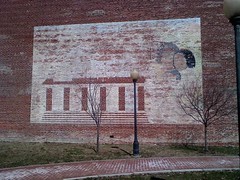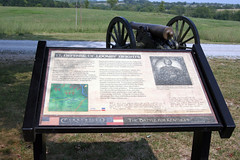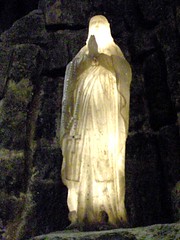Lisboa 09 07 - Atores na Rua Augusta promovendo o Museu da Água | Some actors in Augusta Street promoting the Water Museum of Lisbon [candid video]
Fort Apache Cemetery, White Mountain Apache Reservation, Fort Apache, Arizona

Fort Apache Cemetery, White Mountain Apache Reservation, Fort Apache, Arizona
Originally uploaded by The Nite Tripper
This is a photograph of the grave of the wife of an Indian scout in the Fort Apache Cemetery located on the White Mountain Apache Reservation in Northeastern Arizona. The cemetery was originally planned as the burial ground for U.S. Cavalrymen, their families, Indian scouts, their families and civilians working at nearby Fort Apache. The U.S. Army operated Fort Apache from 1869 until 1922. After it closed, the U.S. Government disinterred all of the white burials and relocated them to New Mexico, leaving the Native American burials in tact. The cemetery is badly overgrown but is still in use today.
Glosters C Company Position

Gloster's C Company Position
Originally uploaded by Haksaeng
LTC Carne deployed three of his four companies in a line centered on hilltops near the town of Chŏksŏng, with A Company on the left, D Company in the center, B Company on the right, C Company in reserve, and the HQ and C Troop, 170th Mortar Battery in the rear near Solma-ri. Company A until dawn on 23 April turned back repeated Chinese assaults but finally lost the dominant platoon position that anchored the company’s defense when the remaining 58 men no longer could hold it. D Company managed to retain its position, but like A Company, suffered high casualties. The Chinese largely left B Company untouched and it survived the night intact. LTC Carne decided to pull to remains of the forward companies back, the remains of A and D Companies took positions near C Company, and B Company took position just east of C Company.
Continued Chinese pressure on the UN line forced a retreat to the Kansas Line. There were several attempts to push an armor unit up to help relieve the Glosters, but those attempts failed, leaving the Glosters surrounded. The Chinese on the night of 23 April resumed their attack on the Glosters, hitting the British along B and C Company positions, eventually forcing their way to the high ground within C Company’s defensive position. This left the Chinese in a position to threaten the HQ unit, located across the road from C Company (I took this picture from the HQ position) and the small valley where the mortar troop was located. LTC Carne worried that the Chinese would move quickly to exploit their position, so he ordered C Company and the mortar troop to withdraw to positions near the HQ area, near Companies A and D. This left B Company isolated along the right flank, but LTC Carne think it could make its way in the dark to where the rest of the battalion was located without getting scattered so he decided to wait until daybreak to pull B Company back. B Company throughout the night came under assaults from all positions, but managed to hold its ground. When the B Company positions were no longer tenable, they attempted to break out and move to where the rest of the battalion were positioned, but only 20 men managed to make it through the Chinese.
Bicentennial Memory, Forgotten Mural

Bicentennial Memory, Forgotten Mural
Originally uploaded by rchrdcnnnghm
During the 1976 Bicentennial , Middletown had recently finished a period of urban renewal. A few of the locations of demolished buildings became pocket parks. These parks weer decorated with murals celebrating the bicentennial, the four freedoms etc. Now these murals have all vanished and been painted over except for this one. If I remember my thirteenth summer, this celebrated both freedom of Religion and the diversity of people. I think I remember various religious symbols on the left and the people on the right were of various races and ethnicity. It slowly weathers away. Taken with the phone



